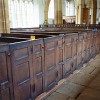In 1661 at the age of 21 William Sydenham inherited from his grandfather the Manor House and estate at Wynford Eagle, which had been the family home since the middle of the 16th century when Thomas Sydenham came from Somerset; it proved to be a poisoned chalice and led to William ending his days in Dorchester prison.
In 1662, a year after inheriting the family home, William Sydenham married Martha Michel from nearby Kingston Russell and the couple had two sons and two daughters, though both boys died at quite a young age. In 1699 a distant relation, Ann, came to live at the Manor House and was employed as a companion to Martha Sydenham and at some time she married Martha’s brother.
For a time William’s father enjoyed positions under Cromwell earning a salary of £1,000 a year. William himself achieved high office as Squire of the Body to William III, but this may not have been enough to compensate for money spent by the family advancing parliament’s cause during the Civil War. For whatever reason, it is clear that by the middle of the eighth decade of the 17th century William Sydenham’s finances were in a parlous state and he needed to find a remedy. By 1690 he had mortgaged the Manor House and most of the estate.
It is likely William discussed his plight with family members and they would certainly have included male members of his wife’s family: one of her sisters was married to Henry Bromfield who was the major mortgagee of the estate and two other mortgagees were named Michel.
In 1700 William decided the answer was a public lottery with the Manor House being the main prize. It seems William had concluded he would not be able to hold-on to the house and estate and was looking for a way to secure his old age.
The lottery appears to have been properly organised and supervised and was held at Mercer’s Hall in London. Interestingly, one of the Trustees was Robert Michel. Two hundred thousand five shilling tickets were available for purchase and if all were sold £50,000 would have been raised. After overheads of about £4,000 and over 13,000 prizes with a total value of about £20,000 William Sydenham would be left with about £26,000.
But everything was not as it should be. On a strictly administrative level William Sydenham should have deposited the deeds of the property and land with the Trustees prior to the sale of the lottery tickets. It appears he didn’t do this, which raises the question: why didn’t the Trustees insist on having the deeds? Furthermore it seems he failed to disclose that the property was heavily mortgaged but as a member of the Michel family was one of the Trustees surely they would have known the property was mortgaged.
All this could be put down to slack administration but when we learn that Martha Sydenham’s companion, Ann, won the main prize – the Manor House – at odds of 200,000 to 1 we have to wonder if there was more than a little dishonesty on the part of someone else as well as Sydenham.
Reports at the time suggest that William Sydenham had arranged for Ann to win the Manor House and then return it to him for a cash reward. But how would William have been able to ensure who the winner would be without some help from those administering and overseeing the lottery? Evidently it seems Ann refused to hand the property back to him. Ann, at sometime, married a member of the Michel family but it isn’t clear if the marriage happened before or after the lottery (we are still searching for the marriage record).
Sydenham set out to defraud the public in an attempt to save himself from financial ruin and his family’s name; that much is clear but it is difficult to see how he could have done this on his own. At every turn in this sorry saga the name Michel crops up and one has to wonder if while William Sydenham was busy defrauding the public some members of the Michel family were equally busy plotting his downfall.
Five years after the lottery he still hadn’t handed over the deeds to the Manor House and it was for this that he was sent to prison where he died in 1709. As the apparent beneficiaries of his actions his two daughters were also locked-up.



